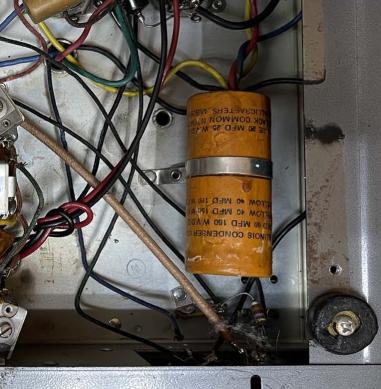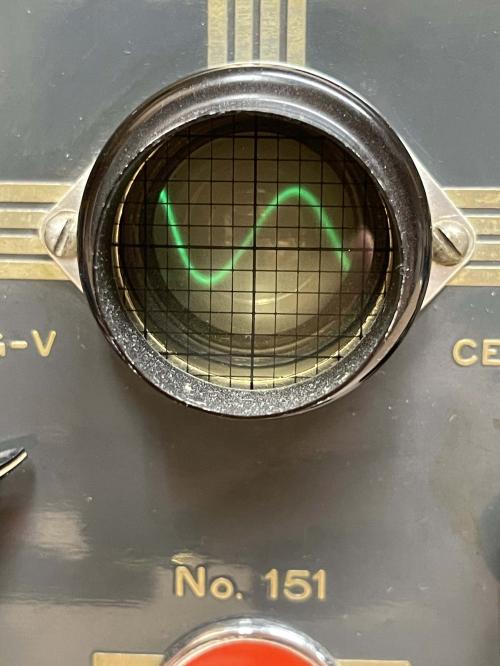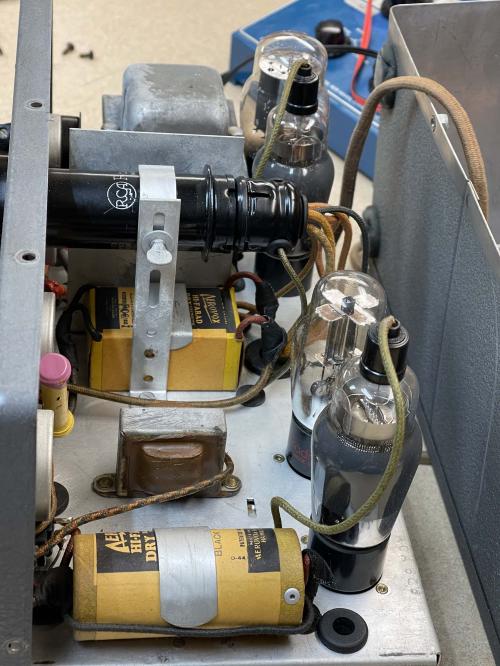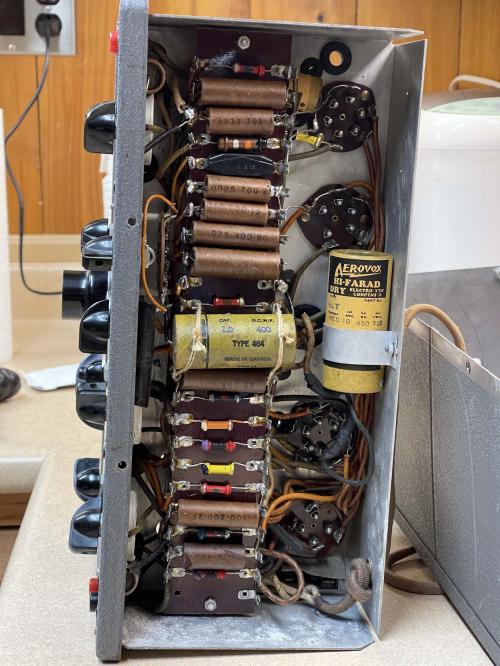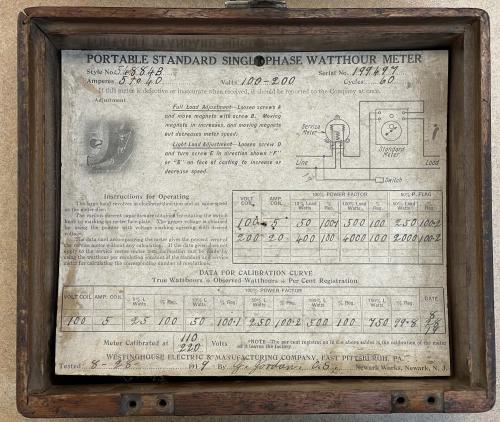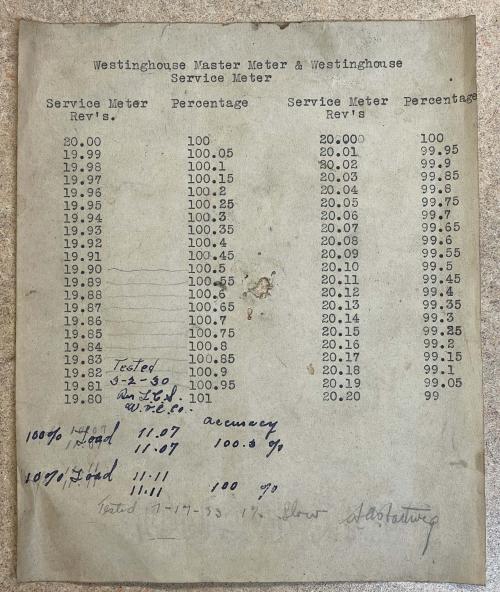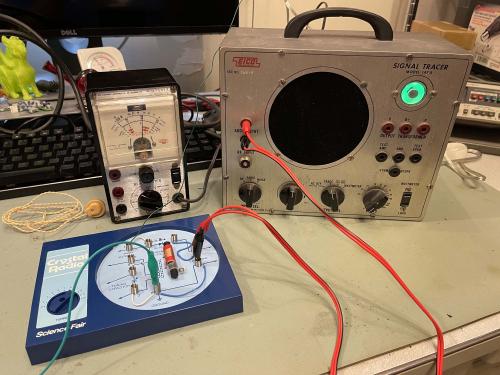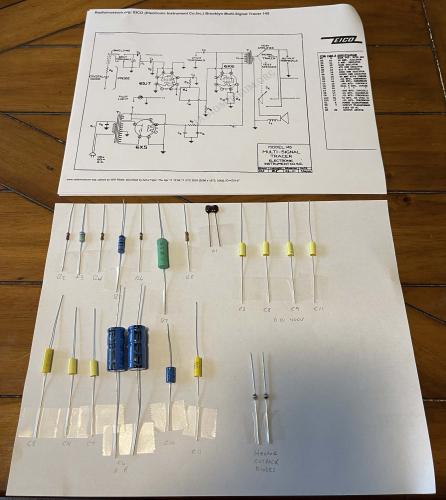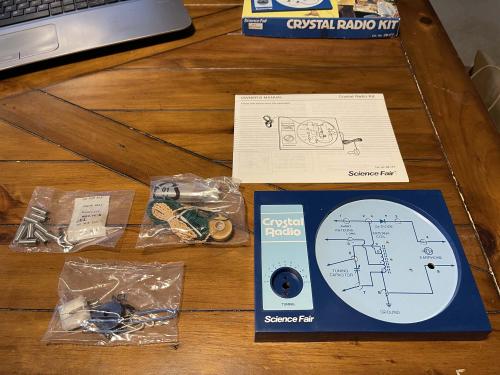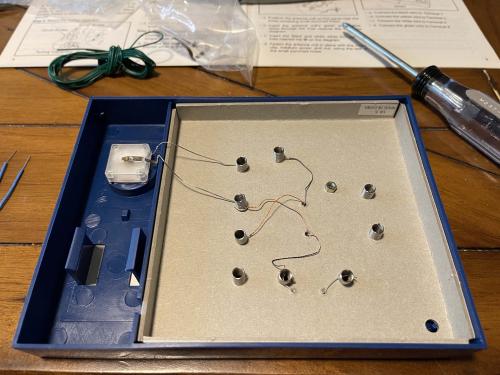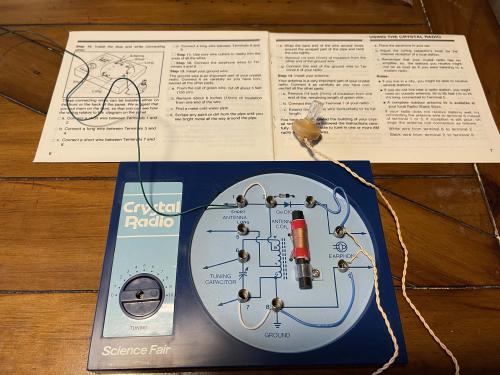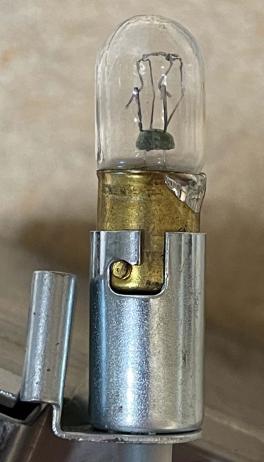- 2024
- Aug
- 4
The dial lamp can be more important than you think.
You’ll notice there’s a #47 lamp (Part# LM1) in the circuit for a lot of transformerless sets like the S-38C. It’s fed by a special tap on the rectifier tube:
It’s just a light bulb, right?
Yes and no. If you look at where it’s at in the circuit, it’s actually helping feed input current to the plate of the rectifier. This has the effect of both providing said current for the tube, and limiting the current available to the tube - you can draw about 60mA in this configuration.
So, do you need this bulb?
Again, yes and no. There are configurations where the tube is fed directly from the AC line, and this is a perfectly acceptable method. However, in our case of having the bulb, you have a bit of voltage drop to the plate which results in a lower output voltage, so you’d need to take this into account if removing the bulb - i.e. you need a resistor for some voltage drop. There’s also the fact that it is providing the AC current input - if you remove it, all of your current is now being sourced by the connection from the heater, and you’re stressing the tube. The radio won’t quit - but it just told you “Hey, I need service.”
In this case, the bulb is a component of the circuit that does more than provides light - it’s ballast for the rectifier and is providing a path for input current. It’s as necessary as the rectifier itself. You can’t replace this with anything other than a incandescent bulb without modification, so don’t grab an LED replacement for this one.
Fortunately, places like Antique Electronic Supply sell packs of 10 for under a fiver, so you can pick up a bunch and drop them in your parts bin. You probably want to do that anyway to get one that isn’t more tungsten boil-off than light bulb.
- 2024
- Jul
- 31
Replacing the filter capacitors in a Hallicrafters S-38C
One of the things I picked up at Dayton this year was a really nice example of an S-38C multi-band radio. Completely untouched inside, it of course has bad filters. That’s par for the course for one of these. (It probably also has some silver mica disease, but that’s another day’s problem!)
Replacing them is easy enough, but it all depends on how you want to do it. Some prefer to keep it original, opening up the can on the multi-section device and putting new components inside. Others just wrap capacitors wherever there’s a place to put them. I’m thinking of going a different direction with this one.
Most of Hallicrafters low-end transformerless sets used similar multi-section capacitors and dropping resistors.
(Schematic from the Riders Manual.)
Some, like this one, used a 220Ω and 1kΩ resistor, others (like the S-95) used a 470Ω instead of the 1K.
So…why not create some sort of universal PCB that can drop in and replace all of the filter capacitors, sans the cathode bypass capacitor used in the audio stage of some of the units?
I had thought of using axial devices, but those can get expensive. What’s not expensive, and are compact and readily available? Surface mount parts. A small board could be created with three capacitors and space for the two dropping resistors, pre-assembled (or partially, depending on what you’re trying to fix,) and either double-side taped in or bolted down. The board wouldn’t need to have any through holes, wires could simply lay on pads and be soldered down. 5W resistors and 160V capacitors exceed original specifications, and would be easy to install on the board.
There’s certainly plenty of room in the device once the original can has been removed.
Wow, those feet are in bad shape…need to find some replacements!
I know that idea will offend some purists, but that’s not my concern here. I want to get the device back up and running with good quality parts that fit in the space required, without drilling a lot of holes or simply shooting parts all over the place.
I just need to brush up on my PCB skills, and lay out the board for sizing. Stay tuned!
- 2024
- Jul
- 17
A cheap Chinese radio kit.
I picked this radio kit up from a popular import site. I’ve seen a couple of them built on random videos, and the price was right (under $10 shipped…) They work, but yeah, it’s cheap.
The kit consists of a case, board, parts, and “instructions.” No alignment notes or anything, so I hope this thing is 455Khz…
The instructions are literally just a schematic and parts placement diagram of sorts. It assumes you know how to align the radio, I guess!
If I get around to putting it together, it will be a bit of a challenge. Who knows when I’ll get to this.
- 2024
- Jul
- 7
The RCA 151 Oscilloscope
This is probably the second oldest piece of equipment that I have in my collection, but this one is known working.
The RCA 151 Oscilloscope (or, oscillograph as it was known at the time) was one of RCA’s early test equipment products, and was supposedly one of the first scopes that was considered “affordable” enough for a small radio shop or well-off hobbyist to purchase. It’s not calibrated in any way, shape, or form, and doesn’t have the ability to lock on a trace - it’s just a purely visual indicator to see waveforms as they travel through a device. It has a top end of about 15Khz, and utilized a 1” RCA 913 tube for it’s display.
Of note here is the overall good condition of the device, both inside and out. I don’t think it was used much. Also of note is the input jacks - I believe these were biding posts at one time, but someone replaced them with banana jacks. Note the burn mark on the right where a hot lead hit the chassis instead of the jack!
The device (and others like it) were made in Canada. This one is unusual in that it was meant for the Niagara Falls power standard of 25Hz - a system that was available until 2006, when equipment failure wrote out it’s final chapter.
It works fine on 50 or 60hz, the 25hz functionality being provided by some extra filter capacitance. As far as I can tell, nothing else changed.
If you’d like to read about that power system, the IEEE published a whitepaper on it in 2008. You can retrieve it from their website by clicking this link or, in the event that they no longer offer it, by using this link that will download it from my document storage site. This is a PDF document.
The cord and grommet appear to be original, from pictures I’ve seen. The technician plug, however, is probably fairly modern - no earlier than the 60s.
So, let’s get some stuff out and try it! My trusty CSC generator has outlived pretty much anything else I’ve had, so we’ll set it up.
The display tube itself isn’t very bright. It’s just enough to see in a lit room, but works well enough. I don’t think this is age, I just don’t believe these were very bright to begin with.
It doesn’t lock because there’s no sync of any sort, so you have to mess with things to make it stable - and then it generally starts rolling again. As said, this was simply to show you the waveform.
What’s inside? It’s a relatively simple circuit consisting of a Type 80 rectifier, two 6C6 for amplifiers, and an 885 Thyratron for the sweep - essentially this is like SCR sweep in a late Sony CRT Television.
Everything is in really superb shape here - no rust and very little oxidation on anything. This thing must have been a prized piece that sat on a bench.
Note the capacitors - that big box capacitor in the middle has been spliced in and the joints coated with old-school cloth electrical tape. I would assume that RCA would have used their own brand parts at this time, and not Aerovox capacitors, but I’m not sure - but this most certainly was repaired at some point. The old dry Aerovox ‘lytics are still good, to this day, so whatever technician made that choice - I salute you, sir.
The bottom shows the parts of the era. Dogbone resistors and lots of capacitors here with minimal marking. It’s all on a terminal board, so completely rebuilding this would be easy, if it was necessary. I don’t ever plan on using this thing on a daily basis- so it’s not.
There’s more of those Aerovox capacitors. Maybe that was original? Did RCA just take an off-the-shelf unit and splice in an extra capacitor for the 25Hz model?
The entire thing has that “smell” of old electronics. You know what I mean.
Last - the paper label inside is still intact.
Time to put it back together and back on it’s display shelf.
There’s plenty of information out there on this device, including ads and manuals. A good source for that information is located at The Oscilloscope Museum, which displays it’s own example of the device. An advertisement for the device (also from the aformentioned site, check it out!)
_

My device cost $44.95 - that’s $1015 today!
Maybe not so cheap for a well-off hobbyist, but certainly invaluable to the radio shop…
- 2024
- Jul
- 5
The Westinghouse 54884B Watt-hour Meter Standard.
This is probably one of the oldest pieces of equipment in my collection that could sensibly be considered “electronics.” This is a watt-hour meter made by the Westinghouse Company of Pittsburgh, PA, and was designed to be used as a calibration standard for other measurement systems.
While the case itself has seen some better days, it’s still relatively intact for a device from 1919. A few cracks, and the hinges were missing when I got it. It has a lovely brass nameplate on the top:
I love the patent dates here. That’s 1895.
The actual range is selected by a big knob in the middle. There’s no clunk of detents, but the knob has two pointers. They’re lableled “1” and “2” - the knob turns all the way around so I assume that it’s a brush inside the device riding on something that connects a shunt for the current portion of the meter. Not sure at this point, however. I have to assume that the numbers are for the incoming voltage range - but again, not really sure.
The really cool thing about this device is the instructions and original calibration card are still in the lid:
And even more cool? There’s a calibration sheet with notes from 1930 and 1933 on it:
But the million dollar question here is does the thing still work? No idea right now. I need to open it up and make sure there’s nothing inside that’s broken first, and do a little study on the instruction card. For now, it’s just a neat display piece, but could potentially be put into service in a pinch - if the innards are still good!
Stay tuned for pictures from inside the device.
- 2024
- Apr
- 29
An Eico 145 Signal Tracer - Part 4
Not much this time, just some prep work for the big stuff.
First was to unsolder and remove the RF jack on the front and find something to put in the hole. This piece of plastic from…who knows…almost fit and will be secured with some RTV later in the project.
You’d never know, but the case was washed.
The handle and some hardware was given an ultrasonic bath to clean it.
The location and year of purchase was noted inside.
And the old, almost hard as a rock cord was removed.
Next is to start removing components. I haven’t decided if I want to do it all at once, or try to do it a part at a time. I can certainly get cleaner results removing everything and doing it all at once. I have the assembly manual, so - probably all at once. Stay tuned!
Next part of this series: https://wereboar.com … ignal-tracer-part-5/
Previous part of this series: https://wereboar.com … ignal-tracer-part-3/
- 2024
- Apr
- 23
A Radio Shack 28-177 Crystal Radio Kit - Conclusion
After returning home to my high-signal area, I hooked the crystal radio up to it’s antenna, and gave it a ground through the building to earth. As expected, several stations were available for listening.
As for the kit itself, it performs pretty much like you’d expect. Selectivity is poor, but the stations I did receive came in loud and clear. The only problem I had was the earpiece appears to have a broken connection somewhere - not surprising, seeing as it was coiled up for 30+ years and is probably a little crispy. It’s not like those were high value items to start with! (They’re still available if you want to pick up some from a well-known auction site on the bay.) I simply grabbed the trusty signal tracer for my listening pleasure.
Overall? Works as expected, and I had fun putting it together. Now to listen to…eh…nothing much of interest. Oh well.
- 2024
- Apr
- 21
An Eico 145 Signal Tracer - Part 3
Now that I’ve verified that the unit works, it’s time to get it ready for rebuild - that means ordering parts.
I’ve created a list of parts to order. I’ve stayed with carbon film resistors, or metal film if they were more reasonable - carbon film seems to be fading in availability. I did make two changes - one is the cathode resistor for the 6K6 output tube, the other is the power supply divider.
From everything I’ve read, the 6K6 was run a little hotter than than it should have been, and a 1K (versus the original 470 ohm) has been used to cut down on the output power. We’re not really concerned with power output here, this is a signal tracer - not a stereo amp. This should help any new output tube used stay useful longer.
It’s still a 2W resistor, metal film instead of the original carbon comp. The bypass capacitor has also been re-added, as it appears to have never been installed.
The second change is the power supply divider resistor. This has been increased to a 7W resistor with a voltage rating high enough to withstand the power supply voltage. You’ll notice in the original pictures, this was a long carbon comp resistor. While power is a concern here, the the voltage rating of the resistor is the main concern. 300V in a power supply could arc across a short carbon comp resistor, To increase the voltage rating, they were simply made longer to give you more space between input and output.
Now, that’s not a problem (as much,) but you still need to be mindful of the voltage rating of the part. In this case, I’ve chosen 500V. This, and the power rating far exceed what’s needed. However - it’s wirewound instead of comp. Inductance in the circuit could change the output voltage a little. Not that we really care, but it’s something to watch out for. I certainly wouldn’t do this in the audio part of the circuit.
All capacitors are as close to the values as you can get in a modern part. 0.01s are readily available. 0.05 is now 0.047, 0.002 is now 0.0022. All are 400V, except for the across-the-line capacitor, which I chose 630V for. The 50pF mica is probably fine, but a new one was purchased just in case.
Electrolytics, of course, have to go. 8uF are now 10uF. This is both someplace you don’t want to scrimp on, but you don’t want to go crazy with. You don’t need transistor device filtering here, so always stay around the original value. With 8uF, you could use 10, 15, 22…no issues. Don’t start sticking 100, 1000, or more in there - you don’t need it, you run the risk of drawing too much current off the tube as the capacitor charges, and you’ll spend a fortune getting parts with that high of a capacitance and a voltage rating.
There are two schools of thought here on voltage rating for capacitors. One states that higher is better, the other states going far higher than your expected voltage will eventually destroy the part as they can’t stay formed properly. I can’t speak for either, but I was always taught give yourself some headroom but don’t go wild - so that’s what I did here for the electrolytics. I expect 300V max, I went with 450WVDC.
In all, I spent about $48 on parts. Most of that is the electrolytics and the higher power resistors. I could have cut that back some, but I always like to order a few extra parts. It’s not like they won’t get used later.
There’s one other modification I’m going to make here, and that’s the addition of a couple of diodes in the heater line for the tubes. These units were designed to run on 110VAC, not the common 125VAC we get today. That means you get about 7.1VAC on the heaters - far in excess of their rated 6.3VAC. Two diodes, back to back, should cut about 0.6V off, bringing you to a much better 6.5VAC. Still high, but it’s not going to destroy the heaters as quickly. If you really want to be ideal with the thing, a variac to bring input voltage down is the best option - but if you’re going to have this in places that aren’t your bench, the diodes are a good option. I chose 200V, 2A 1N5059 units here - mostly because they were inexpensive and about 2x rated current, and somewhat because these round glass body diodes look kind of cool. They’ll go on a phenolic terminal strip.
Next step was to inventory everything and compare it to the schematic and parts list. There’s not a lot here, but I seem to have everything I need save for the bits I’m going to get from stock at the bench.
Next step is rebuilding…do I want to just yank everything and replace it all at once or do it part by part? It’s probably best to do it the latter way, but doing it the former way allows you to clean up everything and make it look nice. I’ll think about that for a while.
Until then, stay tuned!
Edit: I did decide to go with a nice aluminum cased resistor for the power supply divider. The one I originally chose was wirewound, that shouldn’t make a difference - but a nice resistor with a heat sink should keep this thing going for years.
Next part of this series: https://wereboar.com … ignal-tracer-part-4/
Previous part of this series: https://wereboar.com … ignal-tracer-part-2/
- 2024
- Apr
- 20
A Radio Shack 28-177 Crystal Radio Kit
This kit used to be a staple of Radio Shack’s lineup. It’s nothing more than a simple crystal radio kit with a tuning capacitor, ferrite bar antenna coil, and a 1N34 or equivalent diode on a simple plastic cased paper breadboard. The plastic chassis was reused for many things, as evidenced by the battery holder on the bottom, and the multitude of devices that were presented in the catalog.
This particular example is brand new. First thing to do is inventory all the parts, and they’re all here in 3 bags.
1 - Spring terminals and free candy.
2 - Ferrite bar, earpiece, antenna wire, and diode.
3 - Capacitor, knob, wires, and screws.
The chassis and manual complete the parts included. You’ll need a piece of wire for a ground - the manual suggests using part of the antenna wire. I had some 18ga primary wire in my toolbag, I used that for this test instead.
Assembly really only takes about 15-20 minutes. Punch out the holes for the springs, install them, then the diode, tuning capacitor and ferrite bar.
The only issue here was determining what wire on the ferrite bar’s coil went where. The color on the white and yellow wires was somewhat faded from years of storage. There was just enough left that, with some close-up examination, I was able to determine where they went.
Assembly was finished, with just the antenna, ground, and earpiece to add.
(The ground wire was connected after the picture was taken. It went right to the earth of the building I was in.)
Unfortunately, the area I was in didn’t have any strong AM stations around, so there was nothing to listen to. I was able to get some electrical noise on the earpiece, so it’s at least working. I was going to demo the device connected to a signal tracer, but that’s going to wait until I can get to a location with better signal strength.
Stay tuned!
- 2024
- Apr
- 13
This 1986 Ford Radio.
One of the things that caught my eye at the Cuyahoga Falls hamfest this past Saturday was a car radio sitting on the table by the door - the one that’s “Take what you want, pay what you want.” It’s nothing special, just an old Ford AM radio. I put some buxx in the bucket for it.
Why? I want a radio that I can put in a panel and mount in my rack, and a car radio is quite noise immune. I want to listen to a station for emergency alerts, and a car radio is a good choice, being designed for harsh service.
This one has some oddities about it, however:
It’s a radio! Yay! This one doesn’t say Philco on it. You’ll notice it doesn’t seem to have a lot of wear on the knobs and the buttons. In fact, there’s none, and even the face is nice and bright (save the dirt from storage.)
The mount doesn’t show any evidence of ever having been bolted up, either.
Even the lamp, which is in a shielded tube mounted away from the faceplate to prevent plastic burning - a well thought out thing - shows no tungsten burn off. The picture doesn’t really show it, but the brass body is just-out-of-the-box shiny.
I don’t think this was ever mounted in a vehicle. Even the socket pins look new, there’s no marks that I can see on them, and installing it even once would leave some sort of evidence. Inside is similarly clean, there’s not even any evidence of wear on the tuning assembly.
I wonder what it was for? Dealer stock from back when you could get a car without a radio if you wanted it, or perhaps a repair device that was never used?
The inside is a thing of beauty. 4 cans, 3 trimmers, and nothing other than discrete transistors.
Even the label is cool. Ford Aerospace.
So the next thing is to hook it up and try it…and I don’t have any 4 ohm speakers these days. That’s easy enough to get, I can probably pick up something at the next show, which is in a couple of weeks.
This radio seems to fit the bill for what I want to do with it, and the fact that it looks like it’s still new is quite the bonus. I’ll post results when I get it hooked up.

